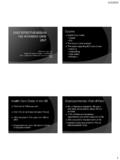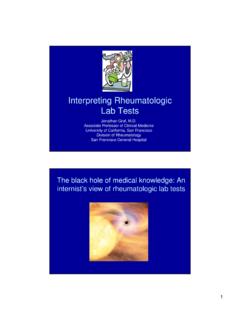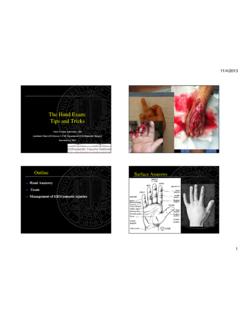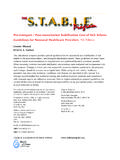Transcription of Indications for Liver Transplantation - UCSF Medical …
1 Indications for Liver Transplantation Nathan Bass MD, PhD, FACPUCSFO verview Liver 101 Function Cirrhosis of the Liver Mechanisms of disease Causes Complications Indications for transplant Contraindications to transplant Organ allocation Special circumstances - MELD exceptionsOverview Acute Liver Failure Definitions Causes Management Role of Transplantation Determining prognosis OutcomesThe Liver - What it DoesDetoxificationSynthesisBlood clotting factorsPlasma proteinsStorageMetabolic & nutritional controlDigestionImmunityCirrhosis of the Liver & End-Stage Liver DiseasePathophysiology of Liver DiseaseThe FundamentalsOrgan InjuryRegenerationRepairScar formationInciting AgentsDeathRecoveryChronic disease/CirrhosisRepeated or Chronic InjuryLiving Donor TransplantationMade Possible by RegenerationRight Lobe GraftLeft Lobe GraftPhotos courtesy of Robert S. Brown, Jr. MD, MPH; Columbia-Presbyterian Medical Center, New CirrhosisChronic toxic insultChronic viral hepatitisAutoimmune diseaseFatty Liver diseaseTissue destructionInflammationScarringRegenerat ionHistologyStage 1 Stage 2 Stage 3 Stage 4 Causes of Cirrhosis Chronic Viral Hepatitis Hepatitis C Hepatitis B Alcohol Nonalcoholic steatohepatitis Cryptogenic Autoimune diseases Primary biliary cirrhosis (PBC) Primary sclerosing cholangitis (PSC) Autoimmune hepatitis Metabolic/metal storage diseases Hemochromatois Wilson Disease Alph-1-antitrypsin deficiency Pediatric Liver diseases Biliary atresia Inborn error of metabolismJaundiceVaricesMuscle wastingEncephalopathyAscitesBruisingPort al Hypertension: Varices Hypersplenism - CytopeniasGastro-Esophageal VaricesRisk of Bleeding.
2 - Large size - Liver failure (Child Class C cirrhosis)AscitesProgression of Ascites to Renal FailureHepatic EncephalopathyWest Haven ClassificationStageConsciousnessPersonal ity & IntellectNeuro-motorAmmonia levelEEG FindingsGrade 0 Sub-Clinical(MHE)NormalNormalImpaired psychomotor testingNormalNormalGrade 1 Insomnia, disturbed sleep patternConfusion, forgetfulness, agitationTremor, constructional apraxia, incoordination Slightly abnormalGrade 2 LethargyDisorientation, bizarre behaviorAsterixis, ataxia Slowing of triphasic wavesGrade 3 Somnolence, but patient may be arousableDisorientation, aggressionAsterixis, hyperactive reflexes, positive Babinski s reflex Slowing of triphasic wavesGrade 4 Coma, unresponsiveComaDecerebrate posture Slow waves (2 to 3 cycles per second)Abou-Assi S, Vlahcevic ZR. Postgrad ;109 for Liver Transplantation Fulminant Liver failure Complications of cirrhosis (variceal bleeding, hepatic encephalopathy, ascites, hepatorenal syndrome) Hepatocellular carcinoma Pulmonary syndromes Hepatopulmonary syndrome Portopulmonary hypertension Polycystic Liver disease Metabolic diseases ( Liver -based causing systemic disease)
3 Familial amyloidosis Primary oxaluria Glycogen storage disease Urea cycle enzyme deficiencies Tyrosinemia MSUDC ontraindications and Controversies in Patient SelectionAbsolute Contraindications Extrahepatic malignancy Liver cancer with macrovascular invasion Untreated AIDS Severe, uncontrolled systemic infection Multiorgan failure Advanced cardiopulmonary disease Irreversible, advanced brain damage Active substance abuse Lack of psychosocial support Technical/anatomical barriersContraindications and Controversies in Patient Selection Relative Contraindications HIV seropositivity/AIDS on HAART Methadone maintenance Stage 3+ hepatocellular carcinoma Cholangiocarcinoma Re- Transplantation for end-stage recurrent HCV Morbid obesity Advanced age Severe physical deconditioningLiver TransplantationMajor Differences From Kidney Transplantation No artificial organ support Critical timing of Transplantation High-risk living donor procedure Regenerative organ Recurrent diseases Simple donor matching (ABO, size) Less immunosuppression Immunologically privileged organ Liver Transplant Milestones 1963 - First human Liver transplant by Thomas Starzl 1980 s - Introduction of CySA 1983 - National Institutes of Health Consensus Development Conference.
4 Liver Transplantation is effective treatment 1990 s - Refinement in surgical technique, more potent and safer immunosuppressive drug regimens, improved comprehensive care; prevention of hepatitis B recurrence 1995 - Adult-to-adult living donor transplant in the USA 1998 - Curative Transplantation for Liver cancer 2002 - MELD system of Liver allocation Current 1-year patient survival rates of 85 - 95% Liver Transplants in the US01,0002,0003,0004,0005,0006,0007,00019 8819901992199419961998200020022004200620 08 All DonorsDeceased DonorsLiving DonorsDeceased Donor Transplants 2007 # of Transplants200720082009O Leary JG et al. , Gastroenterology, 2008 Liver Transplants by Etiology of Liver DiseaseUNOS OPTN Data 1992-2007 Liver Transplants by Etiology of Liver DiseaseUNOS OPTN Data 1/90-8/080510152025303519901992199419961 99820002002200420062008 Percent of TotalAlcoholHep CCryptogenicNASHA nnual Total (Range) 03-075673-6493 Liver Transplants by Etiology of Liver DiseaseUNOS OPTN Data 1992-2006O Leary JG et al.
5 , Gastroenterology, 2008 Organ Allocation for Liver TransplantationChild-Turcotte-Pugh Classification1 point2 points3 pointsAlbumin (g/dl)> < (mg/dl)<22-3>3 INR< > (stage)01-23-4 CTP Class: A: 5-6, B: 7-9; C: 10 or more. MLC = 7 Fundamental Change in Rules for Liver AllocationUNOS MELD/PELD Rules - 2/27/02 OLD UNOS RULES Status 1- Fulminant Liver failure Status 2A - ESLD in the ICU Status 2B - CTP C s & HCC Status 3 CTP B s Waiting time NEW RULES - MELD/PELD Status 1A- Fulminant Liver failure Status 1B - severely ill pediatric patients (PELD/MELD>25, ICU) ESLD ranked by severity score (6-40) MELD (Adults) PELD (children <12) Exceptions HCC Other Status 7 - temporarily unsuitable for transplantModel for End-stage Liver Disease Based on simple, objective laboratory variables (plus age & physical data for PELD) MELD for age 12 and up; PELD for <12 Variables identified through multivariate analysis in a population with ESLD Validated prospectively in an independent population with ESLD Reflects the risk or probability of death within 3 months if the patient does not receive a transplantModel for End-stage Liver Disease MELD Risk Score = 10 x [ x log e (creatininemg/dL) + x log e (bilirubinmg/dL) + x log e (INR)] + Minimum values for creatinine, bilirubin and INR = Creatinine maximum value = (actual or default on dialysis) Score rounded to the nearest integer (range of 6 - 40)PediatricEnd-stage Liver Disease Score PELD Risk Score = 10 x [- x log e (albuming/dL) + x log e (bilirubinmg/dL) + x log e (INR) + (if <1 year old) + (if growth failure present < -2 Standard deviations)] Minimum values for albumin, bilirubin and INR = Score rounded to the nearest integer (range of 6 - 40)
6 MELD/PELD Advantages Objective Works reasonably well to represent expected 3-month mortality Disadvantages Under-represents risk in some patients Hepatic encephalopathy; refractory ascites Does not represent impact of disease on quality of life Can be affected by unrelated interventions or disease Inter-OPO & Inter-regional disparity Geographic Prioritization in Liver Allocation Status 1A and 1B Local, Regional, National MELD =>15 Local, RegionalUNOS RegionsMean MELD ABO=O30 Mean MELD ABO=O22 Mean MELD ABO=O24 MELD ExceptionsIndications for Liver Transplantation Fulminant Liver failure (acute Liver failure + altered mental status) Status 1A Complications of cirrhosis (variceal bleeding, hepatic encephalopathy, ascites, hepatorenal syndrome) MELD Hepatocellular carcinoma Pulmonary syndromes Hepatopulmonary syndrome Portopulmonary hypertension Polycystic Liver disease Metabolic diseases ( Liver -based causing systemic disease)
7 Familial amyloidosis Primary oxaluria Glycogen storage disease Urea cycle enzyme deficiencies Tyrosinemia MSUDL iver Transplantation for HCC Selection - Stage 2 (T2) limit Survival rates at four years: 85% overall (of whom 92% recurrence-free) (Mazzaferro 1996) Overall 5 year survival: 70-75% with recurrence rates <15% (Llovet 1999, Yao 2001) Liver Transplantation is overall the best treatment for early HCC if patients can make it to transplantLiver Transplant for HCCM ilan Criteria (Stage II; T2)Mazzaferro et al., 1996 +Absence of Macroscopic Vascular InvasionAbsence of Extrahepatic SpreadSingle, 2- 5cmUp to 3, none > 3cmImproving Access to Liver Transplantation for HCCT umor StageTime on Waiting ListLivingDonorMELDP riorityExpanded Donor PoolExpanded CriteriaBridging Therapies Downstaging TherapiesUNOS Stage CriteriaHCC - Increasing Allocation MELD Priority2002 RULES T1 = 24 points T2 = 29 points Points increase every 3 months waiting2005 RULES T2 = 22 points Points increase every 3 months waiting (eq.)
8 To a 10% increase in mortality)Management of HCCOLD UNOS RULES Status 1A- Fulminant live failure Status 2A - ESLD in the ICU Status 2B - CTP C s & HCC Status 3 CTP B s Waiting time MELD Exception Score Other Conditions That Qualify Polycystic Liver disease Evidence of nutritional failure Familial amyloidosis Biopsy & TTR gene mutation confirmed, adequate performance status Glycogen storage disease Adenomas Hepatopulmonary Syndrome PO2 <60 Portopulmonary hypertension Presence of elevated MPAP [in absence of volume overload] and PVR responsive to Medical therapy Primary hyperoxaluria On HD with Liver biopsy-proven AGT enzyme deficiency Cholangiocarcinoma Protocol in placeAcute Liver FailureAcute Liver InjuryMildAcute Liver Failure (ALF)*Non-FulminantFulminantElevated ALT/AST+ Coagulopathy (INR> )+ Hepatic encephalopathy*~2000 cases per year in the USLoss of Critical Liver Homeostatic Functions Protein synthesis - Coagulopathy (INR!
9 !!) Excretion - Bilirubin (Jaundice) Detoxification -Urea Cycle (Ammonia -Encephalopathy, Brain Edema) Acid base balance - Acidosis Renal homeostasis - Renal failure Immune (Kupfer cell) function - InfectionFulminant Liver Failure Acute Liver injury plus altered mental state 2 to hepatic encephalopathy (HE) Onset of HE: Within 26 weeks of jaundice (General) Within 8 weeks of initial symptoms (UNOS) Severe coagulopathy No evidence of pre-existing chronic Liver disease** Exceptions Wilson s Disease AIH Alive at 3 wks89%Alive at 3 wks89%1321 FHF subjects enrolled549 (42%) listed1321 FHF subjects enrolled549 (42%) listedSpontaneoussurvivors 47%Spontaneoussurvivors 47%Died NotTransplanted 28%Died NotTransplanted 28%Transplanted 25%Transplanted 25%Overall survival: n = 912 (69%)ALFSG OutcomesEtiology of ALF in the USIndeterminate15%Indeterminate15%Acetam inophen46%Acetaminophen46%DrugDrugViralV iralAutoimmuneAutoimmunePrescriptionDarv ocetFioricetLorcetLortabMidrinNorcoNorel PlusPercocetTylenol with CodeineUltracetVicodinOTCT ylenolDayquilTherafluFeverallLegatrinNyq uilExcedrinPamprinMedications Containing AcetaminophenCytochrome p450 2E1(phase I)OHHNCCH3O
















